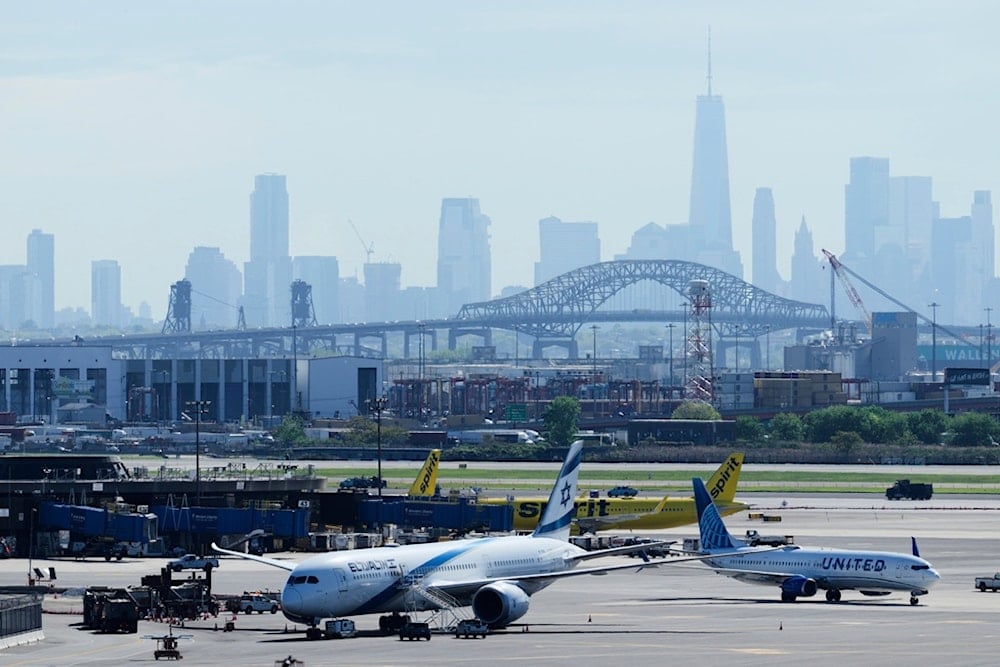Newark airport crisis highlights US air traffic control failures
Repeated system failures at Newark airport in the US expose a national crisis in air traffic control staffing, outdated tech, and delayed FAA modernization efforts.
-

The New York City skyline is seen behind Newark Liberty International Airport in Newark, N.J., on Wednesday, May 7, 2025 (AP)
Twice in just two weeks, communication systems between air traffic controllers and pilots failed at Newark Liberty International Airport, one of the busiest in the United States, The Guardian reported.
The outages, while not resulting in accidents, caused significant delays and renewed concern over what many experts are calling an air traffic control crisis.
The first incident, a 90-second communication blackout on 28 April, left controllers unable to contact planes. A similar failure occurred just days later when a radar outage once again left screens blank for 90 seconds. Thousands of passengers experienced cancellations and long delays. Some air traffic controllers at Newark reportedly went on "trauma leave" following the incidents, further depleting already low staffing levels.
Outdated systems and staffing shortages
Political leaders were swift to respond. Senator Charles Schumer described the Federal Aviation Administration (FAA) as “really a mess,” while New Jersey Governor Phil Murphy blamed “decades of underinvestment” and “inadequate air traffic control staffing.”
A recent inspector general report revealed that 20 of the country's 26 most critical airports are operating with staffing levels below 85% of the FAA's minimum standard. Controllers are often working 10-hour days, six days a week. Newark, in particular, has been singled out for being severely understaffed and technologically outdated.
Secretary of Transportation unveils air traffic control modernization plan
In response to the growing crisis, US Secretary of Transportation Sean Duffy unveiled a comprehensive FAA modernization plan last week. The proposal includes replacing "antiquated" communication systems with fiber optics, wireless, and satellite technology across more than 4,600 sites.
“A lot of people have said: this problem is too complicated, too expensive, too hard,” Duffy said. “But we are blessed to have a president who actually loves to build and knows how to build,” he added, referring to US President Donald Trump.
Duffy’s plan also includes $5,000 signing bonuses for new hires who complete training, in an effort to "supercharge" the air traffic controller workforce. However, no specific cost estimate was provided, though congressional committees estimate it could require $12.5 billion.
Industry experts warn of deeper, long-term issues
Despite praise from some unions and airline associations, skepticism remains. Industry analysts warn that modernization plans have failed in the past due to political infighting and underfunding.
Aviation safety consultant Jeff Guzzetti noted that many FAA facilities still rely on copper wiring and even floppy disks.
Labor historian Joseph McCartin emphasized that the staffing crisis began decades ago when then-President Ronald Reagan fired over 11,000 striking air traffic controllers in 1981.
Since then, the system has struggled to recover its “natural rhythm", noted McCartin.
The number of certified controllers, now just under 10,800, has been flat for years. The FAA recommends over 14,300. While more than 2,000 are in training, the dropout rate is high, and getting new hires fully qualified can take years, especially at demanding airports like JFK or Newark.
Calls for congressional action to avert broader collapse
In September 2024, the Government Accountability Office warned that 51 of the FAA’s 138 air traffic control systems were unsustainable. Experts now say that unless Congress fully funds modernization and hiring efforts, what happened in Newark may repeat itself at other airports.
“The system has been out of sync" ever since 1981, McCartin noted. “We’ve improved over time, but the FAA still has grave difficulty staffing facilities.”
Sara Nelson, president of the Association of Flight Attendants, called air traffic controllers “the nurses" of aviation, working under extreme stress in a crumbling system. “They’re the ones we all need to applaud right now,” she said.
Read more: Planes carrying congress members collide at Washington airport

 4 Min Read
4 Min Read








